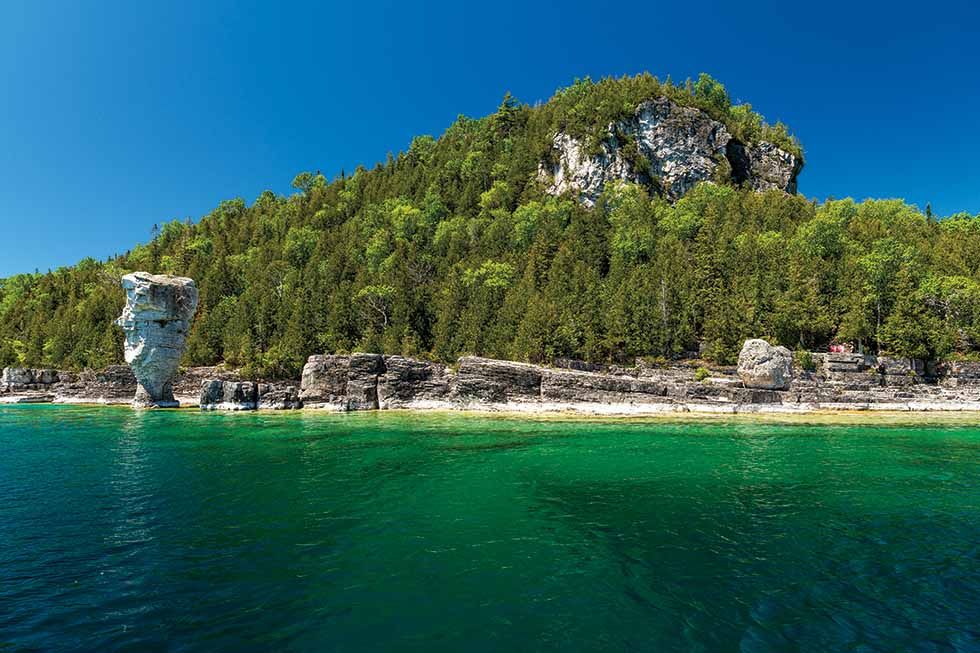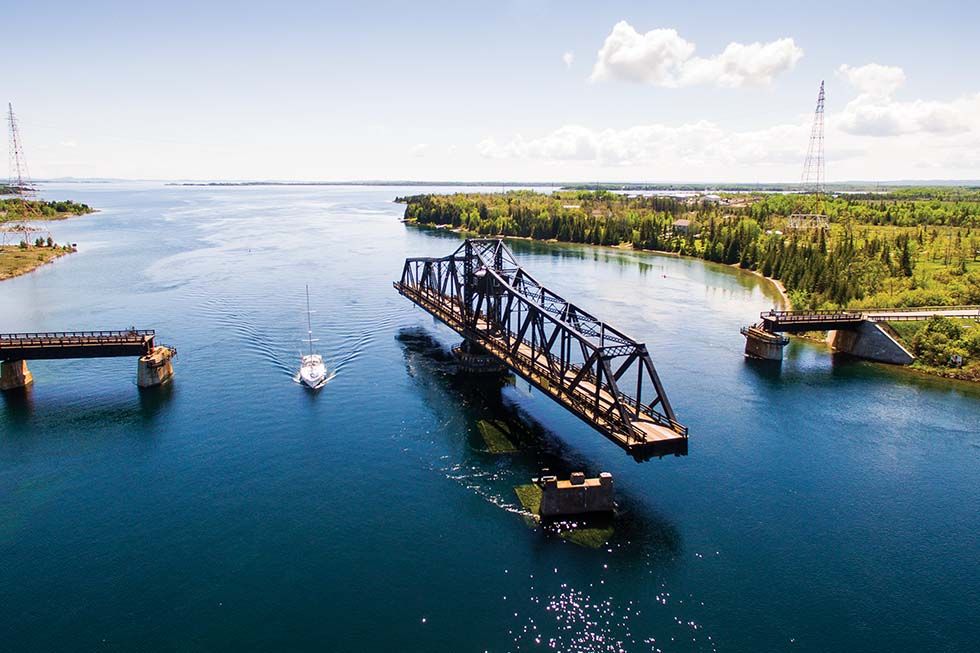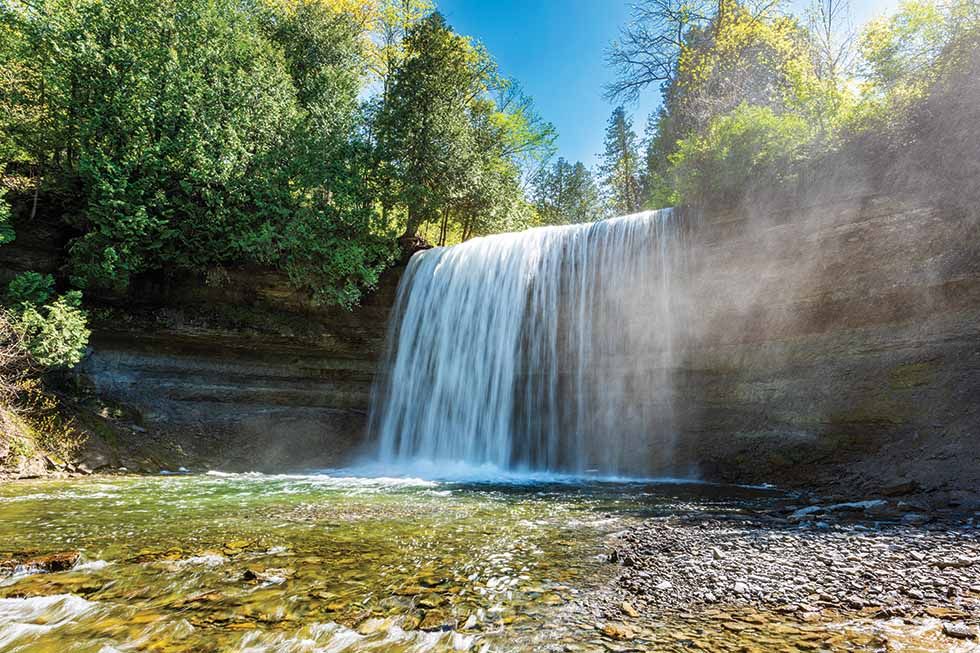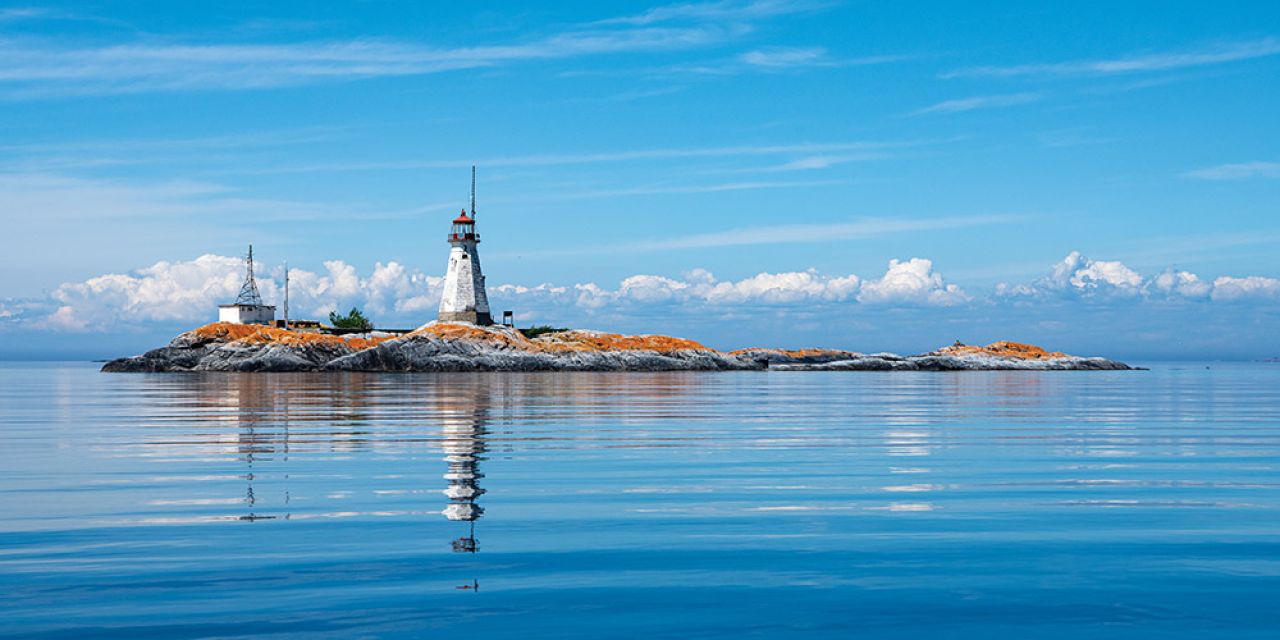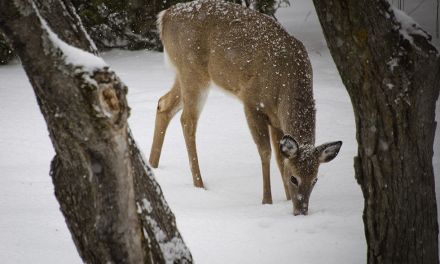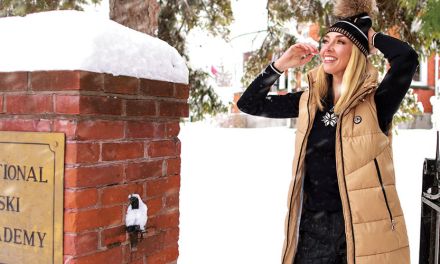Built in 1895, the Western Islands Lighthouse on Double Top Rock is one of the last remaining wooden lighthouses of the Great Lakes
Paradise Found
by Cara Williams | photography by Clay Dolan
From Manitoulin to Christian, Beausoleil to the Westerns, exploring Georgian Bay’s picturesque islands is breathtaking beauty at every turn.
Even though I have lived along the shores of Georgian Bay for most of my life, it wasn’t until a few years ago that I truly began to explore its waterways and islands. Often referred to as the sixth Great Lake, the bay spans approximately 15,000 square kilometres with over 1,996 kilometres of shoreline—that’s nearly as large as Lake Ontario. With more than 30,000 islands, many are best appreciated from the water due to their delicate ecosystems and private ownership, there’s so much to discover. It’s no wonder Georgian Bay is a haven for boaters, offering quiet anchorages, stunning sunsets, and incredible biodiversity.
Between 1200-1550AD, the trade radius of the peoples of this region was 200-400 kilometres. Trade routes brought copper from the west and shells from the east. Fish, game, furs, and other goods were also traded. At the time of European contact, the Ojibwe and Odawa First Nations, both part of the Anishinaabe, lived along the northern, eastern, and western shores of the bay. The Huron-Wendat and Petun peoples inhabited the southern coast, having migrated from the northern shores of Lake Ontario.
Named for Britain’s King George IV by Captain Henry Bayfield in 1822, Georgian Bay is fed from Lake Superior via the North Channel and several rivers, including the Mississagi, Spanish, French, Magnetawan, Muskoka, Severn, and Nottawasaga. The Main Channel, between the Bruce Peninsula and Manitoulin Island, is approximately 25 kilometres wide.
By the late 1800s Georgian Bay was a vital route for shipping and trade, with many vessels transporting timber, minerals, and other goods through its channels. Over 250 lighthouses were crucial for safe navigation, helping ships avoid shoals, islands and treacherous rocky outcrops. Over 130 Georgian Bay light stations are still active today.
In 1969, Georgian Bay was immortalized in Stompin’ Tom Connors’ song “Around the Bay and Back Again.” The ballad tells the story of an island-hopping love interest that Tom can’t quite catch up with: “There’s 30,000’s of lakes and Islands and where can she be found, From grit my baby never hit French River and Sudbury they say, She took a ferry in Tobermory across the Georgian Bay.” This lyrical tribute captures the vastness of Georgian Bay.
The landmasses that surround the bay are remarkably diverse. The west shore features soft, white limestone cliffs, while the east shore is sharply defined by the rugged Canadian Shield, fractured into bays, inlets, and sounds, with thousands of islands strewn along the coasts. The north is characterized by rugged bedrock, while the south has sandy beaches reminiscent of the Caribbean. On the western side, the Niagara Escarpment falls dramatically into deep, crystal-clear waters.
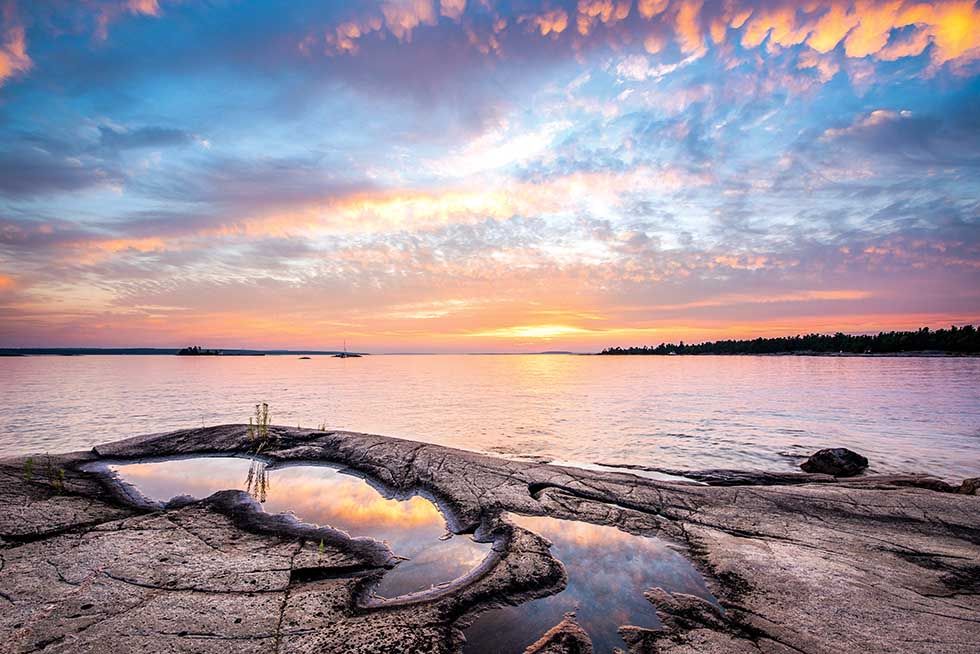
Beausoliel Island at sunset
Surrounded by windswept white pines, scuffed rock faces, and wide, wild waters, Georgian Bay Islands National Park, on the eastern side of the bay, boasts the largest freshwater archipelago in the world. From Beausoleil Island to the French River, 63 protected islands create spectacular scenery and offer safe havens for boaters. Designated as a UNESCO Biosphere Reserve, the park focuses on balancing nature and human activity to ensure future sustainability. In the 1920s, the dramatic landscapes of Georgian Bay Islands National Park famously inspired the Group of Seven. Their paintings, characterized by strong, bold brushstrokes, helped weave Georgian Bay into the fabric of Canada’s national identity.
While the scientific explanation of the islands’ formation is fascinating—granite bedrock was exposed by glaciers 11,000 years ago—the legend is more enchanting: Kitchikewana was a great warrior of the Wendat Huron Nation. Taller than the pines and stronger than the winds, he was revered in war but feared in peace due to his violent temper. The elders decided he needed a wife and introduced him to Princess Wanakita. Kitchikewana fell in love, but Wanakita’s heart belonged to another. Heartbroken and furious, Kitchikewana stomped the ground, creating the five bays of Severn Sound, and threw rocks into Georgian Bay, forming the 30,000 islands. In despair, he walked into the water, lay down, and died. His body is said to be seen today in the shape of Giants Tomb Island.
Beausoleil Island, the largest in Georgian Bay Islands National Park, offers hiking and camping in addition to incredible boating. Named after Métis explorer Louis Beausoleil, it was known to the Anishinaabeg as a “rocky place floating about the mouth of a river.” The land was used for hunting and trading for over 7,000 years and early voyageurs marked it as a midpoint between the Severn River and north Georgian Bay. Now part of the UNESCO-designated Georgian Bay Biosphere Reserve, the park protects significant habitats and cultural sites. Here, you can experience the stark transition from the St. Lawrence Lowlands to the Canadian Shield, walking from pine-covered soil to bare rocks along the trails. Surrounded by early 1900s cottage development, Beausoleil Island remains a haven for nature enthusiasts, offering breathtaking views and encounters with diverse flora and fauna, making it ideal for both day trips and extended camping adventures.
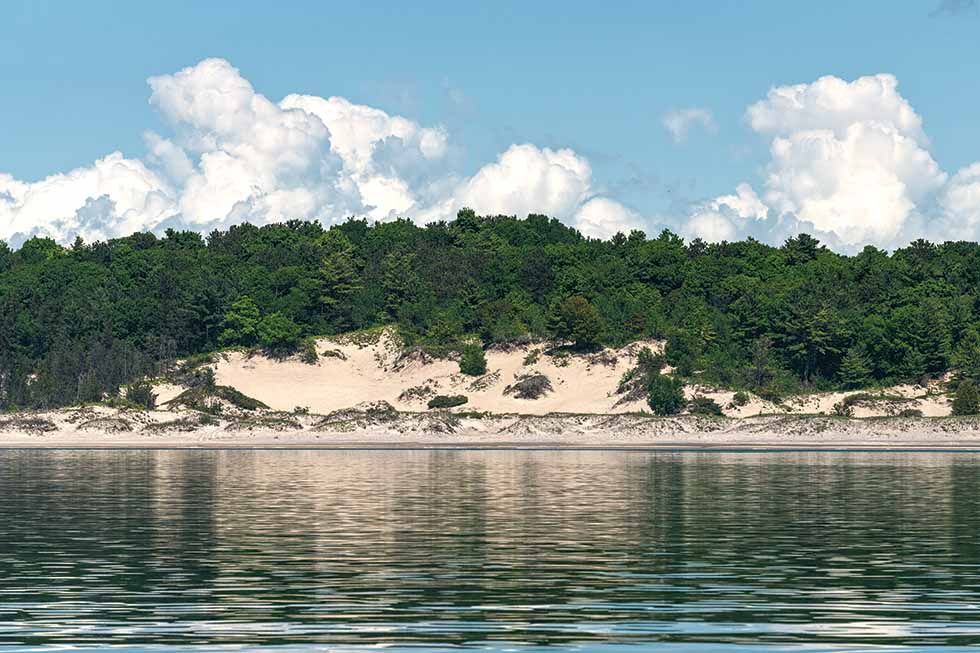
Christian Island sand dunes

South-East Wooded Pine Island
Christian Island, an Ojibwa reserve known as Christian Island Indian Reserve No. 30, has incredible white sand beaches and clear waters for swimming. This island has a rich history and cultural significance, having been a base for the Beausoleil First Nation since 1856. The community maintains its cultural traditions and the island has various amenities and services, including an elementary school, a health centre, and a community centre. A ferry service connects the mainland to the island. Visitors to Christian Island can expect to pay docking fees when anchoring— the same is true at Hope Island and Beckwith Island, which are also part of the Beausoleil First Nation’s territory. These fees contribute to the maintenance and preservation of the islands, ensuring that the natural beauty and cultural heritage are protected.
Considerably smaller at only seven acres, South-East Wooded Pine Island features characteristic Georgian Bay wind-swept white pines surrounded by low-lying glaciated rock. The bedrock has small depressions filled with various wetlands, including small bogs, meadow marsh communities, and seasonal ponds. As an offshore island, South-East Wooded Pine provides critical refuge for migrating birds and serves as breeding habitat for Killdeer. The island is open to the public and is managed by the Georgian Bay Land Trust, a volunteer-driven organization dedicated to protecting and preserving the lands of Georgian Bay.
Venturing northwest, the Western Islands lie more than 20 kilometres from the mainland and have always posed a threat to navigation. The historically busy shipping route between Collingwood, Parry Sound and Midland Bay is guided by the Western Island Lighthouse on Double Top Rock, at the south-western extremity of the group of islands. Built in 1895, the light station included a light tower, keeper’s residence, fog alarm building, and storage facilities. Lightkeepers were dispatched to the island for up to eight months of the year, which is why it earned the nickname “Little Alcatraz”. When the last keeper finished his posting in the late 1980s, the Coast Guard arrived to demolish all buildings except the original lighthouse. They quickly dismantled the boathouse, but the lightkeeper’s house proved more resilient, having been reinforced over the years to withstand wave damage. After a few days with little progress, a case of dynamite was brought to the island, and the sticks were suspended in each room and linked with a detonating wire. The explosion blew the walls and floors apart, but the chimney remained standing, so they were forced to dismantle it by hand. With the original outbuildings removed, the historic wooden lighthouse continues its watch alone. Although the grounds and tower are now closed to the public, the lighthouse, as one of the last remaining wooden lighthouses of the Great Lakes, is a recognized Federal Heritage Building. It symbolizes the maritime history of Georgian Bay and has become a favourite subject for photographers and artists.

Located over 20 kilometres from the mainland, the Western Islands have long been a navigational hazard
Another island revered by artists and artisans is Manitoulin Island—the largest freshwater island in the world. With lush forests, rolling hills, and crystal-clear inland lakes, Manitoulin begs to be painted, sculped and photographed. It boasts nearly a dozen museums and galleries, showcasing both contemporary and indigenous art. Little Current, the largest community on the island, was named for the swift currents running through the passageway connecting the North Channel and Georgian Bay. This vibrant community is not only a cultural hub but also a gateway to exploring the island’s natural beauty and heritage.
The islands between Tobermory and Manitoulin, including Cove, Echo, Russel, Devil, Flowerpot, and Bears Rump, are part of the stunning Fathom Five National Marine Park. Flowerpot Island, with its iconic limestone sea stacks, is a personal favourite of mine. The spectacular pillars slowly formed over many years as horizontally-bedded sedimentary rocks were carved into arches by waves, rain and ice that pounded at the cracks in the stone, gradually wearing away the softer, lower limestone while leaving the harder dolomite top. Once the arches collapsed, only the isolated stacks remained, resembling giant flowerpots. Originally, there were three stacks on Flowerpot Island, but natural erosion caused one to fall in 1903.
Several private tour companies offer glass-bottom boat tours from Tobermory to Flowerpot Island. Once on the island, visitors can enjoy hiking trails, explore caves, camp, and visit the historic Flowerpot Island lighthouse. Built in 1897, the lighthouse tower stands 88 feet tall atop the rocky cliffs of Castle Bluff. Before it was decommissioned, its light was visible for over 22 km. In 1996, Friends of Fathom Five and the Canadian Coast Guard restored the light station, and shortly after, the Lightkeeper’s Host Program was introduced. This program allows volunteers to live on the island, perform minor maintenance, and serve as site interpreters for visitors.
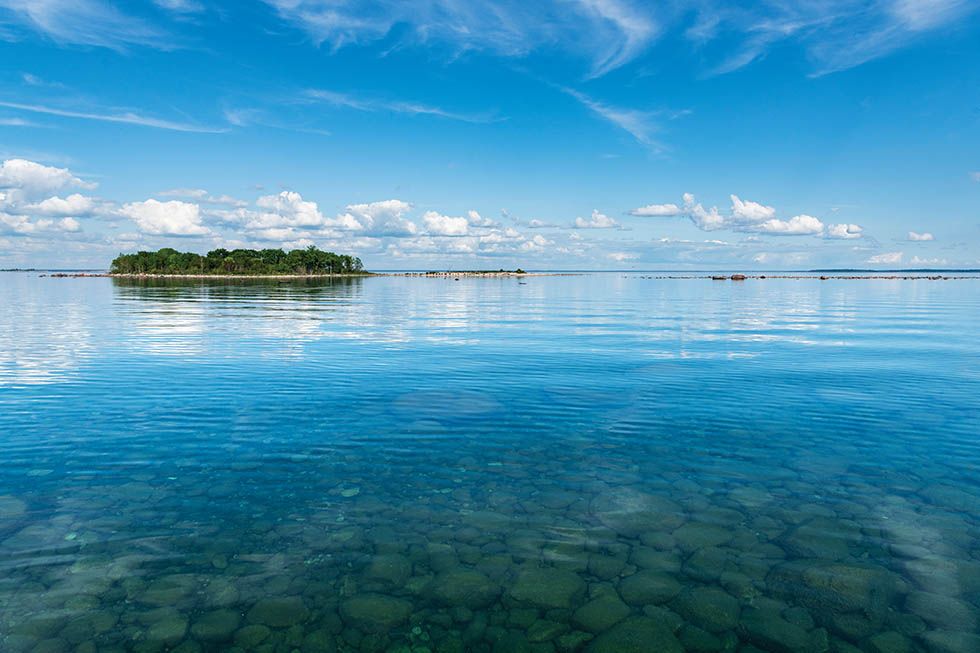
Fathom Five National Marine Park is packed with history, harbouring nearly two dozen shipwrecks. It is world renowned for its clear waters, and diverse marine life, making it a mecca for scuba diving and snorkeling. Islands like Yeo, Lucas, Fitzwilliam, James, Club, and Rabbit offer untamed wilderness and solitude, perfect for those seeking adventure and a deeper connection with nature.
Hay Island, White Cloud Island, and Griffith Island are three private islands in Colpoys Bay, between Wiarton and Owen Sound. Lush woodlands provide these islands with natural seclusion, creating a secluded paradise. The surrounding waters are perfect for fishing and boating enthusiasts, offering calm anchorages and excellent swimming.
Griffith Island, with its intriguing history and secluded environment, spans over 2,300 acres. The federal government maintains a historic lighthouse on one side, while the majority of the island is owned by the Griffith Island Club. This private hunting and sport shooting social club is shrouded in secrecy. Established in the early 1970s, rumoured members include politicians, CEOs, and professional athletes, who access the island via a private ferry. The island also features a 2,700-foot turf airstrip for chartered planes.
The islands of Georgian Bay are a marvel that every boater should experience. With so much to explore, one summer is not enough to uncover all their hidden gems. From the rugged beauty of Beausoleil Island to the iconic Flowerpot Island, each destination offers its own unique charm. Whether you’re into fishing, wildlife watching, or hiking, these islands provide the perfect getaway. Rich in history, culture, and natural beauty, they offer a window into Canada’s indigenous heritage. As you navigate these waters, respect the environment and wildlife. Leave no trace, avoid trespassing, and carry home memories of this pristine paradise. E
